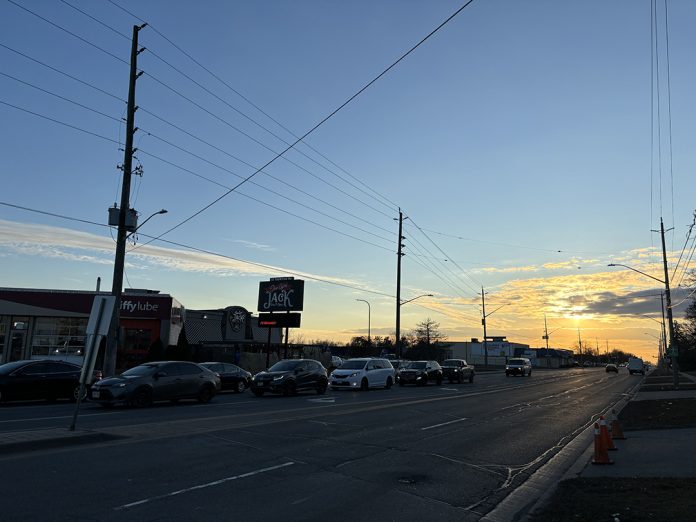Oshawa is known for its diversity, hard working residents, schools and buildings and an appreciation for the arts. The region has gone through many changes, challenges and growth over its history.
As Oshawa reaches 100 years, it presents an opportunity to look back at some of the challenges and change the city has witnessed through the eyes of its residents.
Bill West, 89, has seen first hand a lot of the change that the city has overcome.
“Just the general life of things is a lot different than when I first moved here. There is the obvious change of transportation and what people are doing, but just having access to health care and hospitals now is really good for the community,” West said.
He also noted the diversity of the city and the educational opportunities in Durham Region.
“There’s a lot more interesting people now and people from all over the world. There isn’t a big need to travel super far anymore, that has been a nice change,” he said.
West added that seeing younger people being able to get their education right at home is really important.
“Being 18 and moving out is really hard, so having the chance to get some school done and then move out and go onto other things feels important for the younger folk and something we did not have,” West said.
When West was a younger man, Oshawa was more of an industrial town. There has been a large amount of change both with how the city looks and what it offers.
Dan Carter, mayor of Oshawa, said that while there can be a lot of similarities found in the last 100 years, there has been a lot of progress.
“If you go back to 1924, we had a population of 15,000. We almost have 200,000 people that live in our community (now). Our community has become very diverse, not only in its economy but also in its population,” Carter said. “It’s amazing when you look back at 1924 and you see the attributes of our city then and our attributes in 2024.”
Many of the transformations Oshawa has undergone involve the introduction or construction of buildings aimed at supporting the community, including schools, hospitals, medical facilities and other community-centric structures.
“We have 142 different nations that are represented at our colleges and universities. That’s quite significant,” Carter said. “We have over 11,000 people that work in health care, and we have one of the leading facilities in regards to our cancer care. So there’s a significant change in what’s happened over those 100 years.”
Carter said that having a post secondary education has also added to the community.
“There was a poster that we found that said that we were in the leading edge in regards to post-secondary education in 1924,” Carter said. “Now in 2024, we are leading in post-secondary education with four different faculties and facilities in our community.”
Oshawa is located on the traditional and treaty lands of the Michi Saagiig and Chippewa Nations, territories acknowledged through the Williams Treaties. This land is shared with the Mississaugas of Scugog Island, Hiawatha, Curve Lake, and Alderville First Nations, as well as the Chippewas of Georgina Island, Rama and Beausoleil First Nations.
A document on the City of Oshawa website states how the name “Oshawa” comes from an Anishinaabemowin (Ojibwe language) word meaning “a crossing place” and “that point at the crossing of the stream where the canoe was exchanged for the trail.”
Between 1350 and 1450, Oshawa was inhabited by the Iroquois, ancestors of the Wendat, also known as the Huron.
“The territory of the ancestral Wendat is thought to have extended along the north shore of Lake Ontario from the Rouge River to Prince Edward County. The Grandview Site located south of Taunton Road and west of Grandview Street North, was discovered in 1992 during construction for a new subdivision,” notes the Durham Region website.
Lisa Terech, a member of the Oshawa Museum, said the city has a rich Indigenous heritage and the museum displays important artefacts from the past.
“A group of peoples known as the ancestral Wendat lived in our community in the 1400s. We have some of the objects that belong to these people that were discovered through the archaeological excavations,” she said. “When the settlers arrived in the 1790s, the people who were living here were the Anishinaabe, the Mississaugas.”
Automobiles are also a central part of Oshawa’s history, dating back to the early 1900s.
Oshawa’s famed-McLaughlin family ventured into the automotive industry by forming a partnership with the Buick Motor Car Company of Michigan to incorporate the Buick engine into McLaughlin vehicles. This collaboration led to the production of automobiles in Oshawa starting in 1907. By 1915, the McLaughlin family expanded their business and secured the rights to manufacture Chevrolets, leading to the establishment of the Chevrolet Motor Car Company of Canada.
While Oshawa still has some challenges, Terech said it’s important to celebrate the city.
“It’s good to know about the past of a place so that you can really get a sense of who the people are and where they’ve been,” she said. “Our museum is quite special because we look at social history, so we look at telling stories of people.”
Oshawa is home to many people and is united by its collective resilience, the community consistently comes together to overcome changes and challenges.
Reflecting on his life spent in Oshawa, West described his time as “joyful.”
“I raised my kids here, who raised their kids here,” he said. “Oshawa is just home to me now and to my family.”




